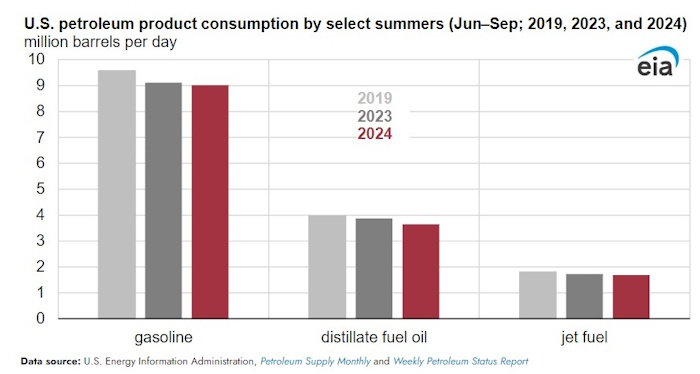Refinery margins for petroleum refiners across the world are shrinking, indicating reduced profitability from refining crude oil and selling petroleum products. Declining margins are the result of relatively weak demand for petroleum products even as global refining capacity increases.
Global refinery margins, measured by the 3:2:1 crack spread, have been less than their five-year (2019–23) averages since the spring and dropped even more in the late summer and early fall. The 3:2:1 crack spread is calculated by subtracting the price of 3 barrels of crude oil from the price of 2 barrels of gasoline and 1 barrel of distillate. This year, the September monthly average refinery margin fell to its lowest for the month since 2020, when there was significantly less transportation fuel demand because of pandemic-related reductions in travel.
The recent drop in refinery margins is a departure from the past two years. Following the lows in 2020, decreases in U.S. refinery capacity and recovering petroleum product demand supported stronger U.S. refinery margins. This trend was particularly true on the West Coast, where several refineries closed or converted operations to renewable diesel in response to its increasing use in the region.
Refinery margins have fallen in part because of relatively weak demand for petroleum products, particularly distillate fuel oil. In 2024, U.S. product supplied of distillate fuel oil (the proxy we use for consumption) averaged 6% less than in 2023 and 8% than in 2019 from June through September, mostly due to declining manufacturing activity and the increasing use of biofuels in place of conventional, petroleum-based diesel fuels on the West Coast. Gasoline and jet fuel consumption were slightly below 2023 levels for the same months, and they both remain 6% below 2019 levels.
Outside of the United States, petroleum product demand has been weak due to slowing economic activity in China and Europe. In addition, increasing adoption of electric vehicles, biofuels, and liquefied natural gas use in trucking is steadily reducing petroleum fuel consumption across much of Asia and Europe. Refinery margins have also been under pressure due to new refining capacity abroad. Kuwait’s 615,000-barrel-per-day (b/d) Al-Zour refinery reached full refining capacity early in 2024, Oman’s 230,000-b/d Duqm refinery has begun operations, and Nigeria’s 650,000-b/d Dangote refinery has been ramping up refining activity. In response to low refinery margins, some global refiners have reduced refinery runs, and some in Europe have announced plans to close or reduce capacity. Although planned before the recent decline in refinery margins, LyondellBasell plans to close its 264,000-b/d refinery in Houston, Texas, by the first quarter of 2025.
Source: EIA









